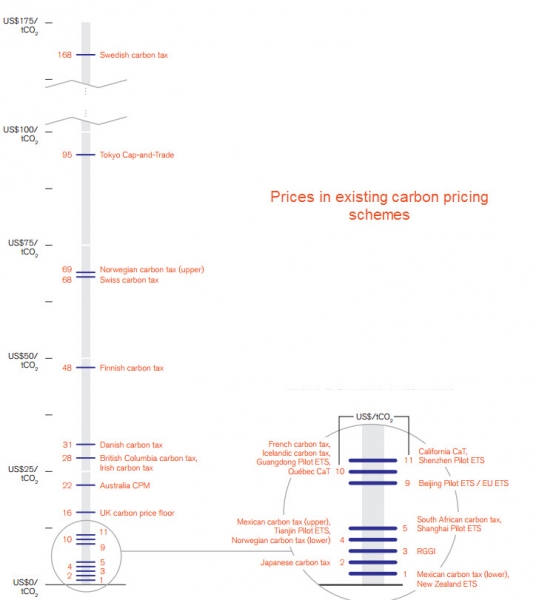In a recent report published in May 2014 by the World Bank Group on Climate Change, titled «State and Trends of Carbon Pricing», surprising and disparate prices per ton of GHG emissions used and applied in accordance with different mechanisms and in different jurisdictions is presented.
In a recent report published in May 2014 by the World Bank Group on Climate Change, titled «State and Trends of Carbon Pricing», surprising and disparate prices per ton of GHG emissions used and applied in accordance with different mechanisms and in different jurisdictions is presented. The described mechanisms are (1) a carbon tax, (2) the implementation of a Cap and Trade mechanism and (3) use of specific regulations on GHG emissions. In several cases, in a same jurisdiction, we found that these three measures were being used simultaneously – fiscal, economic and regulation. To these 3 mechanisms, we could add the carbon price used internally by companies and the one found on the voluntary market, a market that does not depended on any regulations.
We notice on the following Table, produced by the World Bank in its report, that the price for a ton of carbon emission expressed in US $ varies between a few pennies to $ 168 US/tCO2. We also notice that in the upper range (everything that is higher than $16 US/tCO2) we find carbon taxation mechanisms found in Sweden, Norway, Finland, Denmark, British Columbia (Canada), Ireland and Australia (recently abolished)). The only exception is the Japan Cap and Trade which is in force in Tokyo at a price of $ 95 US/tCO2.
It is on the lower range (< $ 16 US/tCO2,) that we found most of the governmental systems using Cap and Trade mechanisms. A first group of jurisdictions at about $ 11 US/tCO2 that includes Quebec, California and China’s Shenzhen project. Then at $ 9 US/tCO2 we found Beijing’s pilot project in China. At the bottom of the range, with everything lower than $ 9 US//tCO2, we found various Cap & Trade systems.
Therefore, the great challenge will be to harmonize and integrate different carbon prices that can be applied in commercial exchanges between regions, states and different countries of the world.

Source: World Bank, May 2014, page 17
To comment our blog: [email protected]
Martin Clermont, CEO, Will Solutions
